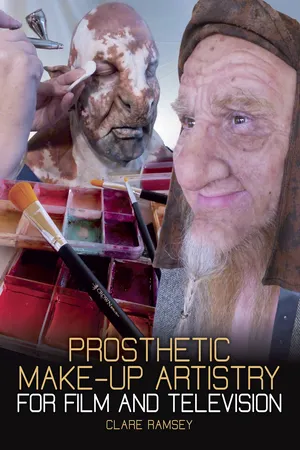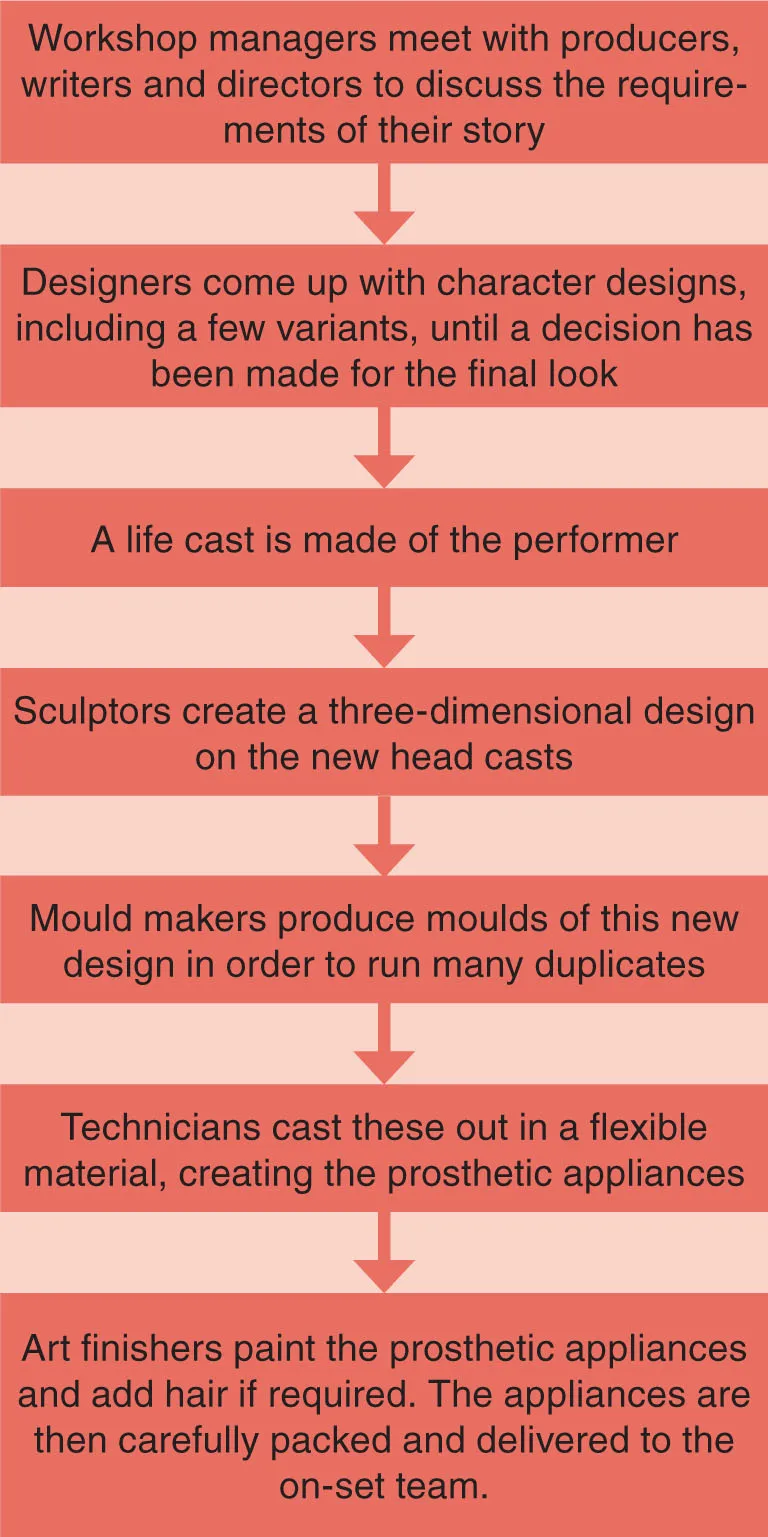![]()
![]()
1
WHAT IS PROSTHETIC MAKE-UP?
Prosthetic make-up involves the application of specifically designed make-up appliances to change the appearance of an actor or performer in some way. These are made in a variety of flexible materials and are glued to a person’s face and/or body.
They are designed to move in a realistic fashion and are primarily used to help tell a story as they allow extreme changes to be made to a performer. Some examples of these extreme effects include ageing, disease, fake pregnant bellies, adding or losing weight, fantasy and horror creatures. The possibilities are limitless.
This book is mainly concerned with prosthetic make-up artistry for film and television, however the art of prosthetics isn’t limited to this medium. It reaches as far as print and editorial work, theatre, cosplay and live-action role play. It is even used to train medical practitioners by simulating casualty effects.
Prosthetic artists often work with surgeons to provide realistic body parts that they can practice delicate procedures on.
THE VARIOUS ROLES OF A PROSTHETIC MAKE-UP ARTIST
Those interested in this craft have a number of options as there are many processes involved in working with prosthetics. Usually at a professional level the process begins in a prosthetic workshop, within which there may be many hands and minds that contribute to the prosthetic appliances an actor wears.
Some artists are based in workshops and deal mostly with the design and manufacture of the appliances, while others work as application artists on TV and movie sets, applying and maintaining the prosthetics on actors and performers throughout the filming shoot. Other prosthetic artists divide their time between workshop and application jobs.
As well as manufacturing prosthetics appliances, workshops also manufacture fake bodies in the likeness of actors that can be used in situations where, for example, death or injuries need to be simulated. Workshops also make masks of actors’ likenesses to be worn by stunt performers in film and TV, as well as simple quick-change prosthetics and masks for theatre. Every job is different and the requirements are always unique.
CONCEPT TO APPLICATION
A prosthetic appliance is developed from thought to reality within the workshop infrastructure
Usually a brand new piece will be required every day an actor is working as each one is destroyed during the removal process, so the workshop will continue to turn out these appliances until the total amount is reached.
Eventually the appliances are handed over to the make-up department on a film or TV set where they are applied by skilled prosthetic make-up artists individually or as part of a duo team.
WORKING AS AN ON-SET PROSTHETIC MAKE-UP ARTIST
When you work as a prosthetic make-up artist on a film or TV set your job involves applying and maintaining prosthetics on a performer. Prosthetics can take anywhere from two to six hours (or longer) to apply. Due to these long application times you will usually be applying the pieces working as a team with another prosthetic artist. Each artist works on one side of the face, crossing over where necessary.
Having two people working together like this reduces the application time, making the process more comfortable for the performer. It oddly becomes like a strange prosthetic dance as both artists work in tandem to create the character. Thus you will need to be able to work well in a team environment.
Depending on the type of prosthetic pieces, however, you won’t always be working in pairs, so you need to be competent and efficient at applying prosthetics alone as well as part of a team.
In an on-set environment prosthetic artists fall under the umbrella of the make-up department, but they are generally separate from the regular make-up team as they often require a specific set of skills and equipment, not to mention the time they need to do their work.
It is the role of the regular make-up team to deal with all the beauty and corrective make-up on the other cast members. They will also handle any small wounds such as scars and cuts, using the two-dimensional prosthetic transfers you will learn about in Chapter 3. These are generally made by prosthetic artists and then handed over to the regular make-up team.
OUT-OF-KIT EFFECTS
Another technique regular make-up artists employ is simply to create the wounds using a method called ‘out-of-kit effects’. Loosely translated this involves applying scar material or collodian directly to the actor’s skin to simulate scars, cuts and small wounds. It is a fast and effective way to create the appearance of injuries, but due to its one-of-a-kind nature it has the disadvantage of never quite looking exactly the same if it has to be repeated. When a make-up must be repeated on a different day the make-up team relies on continuity pictures taken on the previous occasion. These photos have to be copied as closely as possible to recreate the look.
This is why the lesson on flat moulded prosthetics in Chapter 3 is such an important skill to learn, since it will save you a lot of time when it comes to repeating these small designs.
Out-of-kit techniques are also utilized by prosthetic make-up artists when a creature has minor changes, small cuts and wounds that can be applied quickly and then removed as necessary. The appearance and stages of an injury, for example, can change a lot in a day’s filming. You need to be ready to jump in with a quick solution when needed. This topic will be investigated further later in the book.
Generally prosthetic artists deal with the specialized make-ups and creature characters that can’t be done within a regular make-up department. They work closely with each other as often both elements are required on one performer. There is generally a make-up designer and a separate prosthetic designer, but this isn’t always the case and it largely depends on the requirements of the job and the available budget.
Some artists work solely as prosthetic make-up artists, while other regular make-up artists do prosthetics as well. The more skills you have, the more employable you will be.
A TYPICAL DAY FOR A PROSTHETIC MAKE-UP ARTIST
04:00 (or earlier): Arrive at work
Prosthetic artists need a few hours to get an actor ready, time that is allocated before the rest of the film crew arrives. An average prosthetic application time is three hours, during which they will prep the actor’s skin, then apply and paint the prosthetic appliances.
The entire day will be set out on a schedule known as a call sheet. This is a detailed document that explains the plan of action for the day, indicating when the actor will arrive and what scene number they will film. It also informs the team which other members of...



